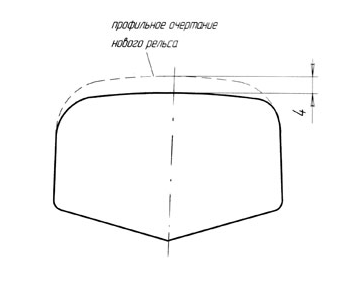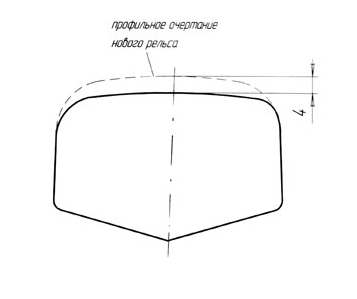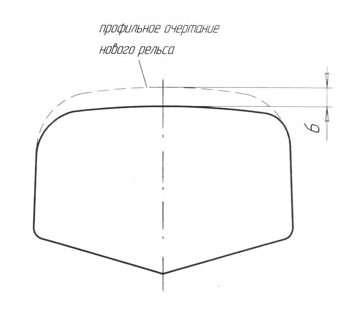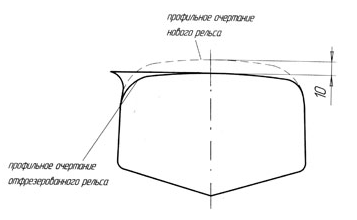Used rails
Starving rails, re-used for laying on the road, must meet the requirements:
· Instructions on the use of old-age rails on the railways of the Ministry of Railways of Kazakhstan;
· Technical instructions on the transfer of heat-strengthened rails of types P65 and P75 in the link path;
· Technical instructions on the re-laying of rail beams of the weldless track welded from heat-strengthened rails of types P65 and P75;
· Technical instructions for grinding rails;
· Normative requirements for grinding rails in the rail track system of the railways of the Republic of Kazakhstan.
The main criterion for assigning rails to a certain shelf group is the normative operating time of tonnage Тн, which for the rails of type P65 is on the average 500 million tons gross.
According to paragraph 5.8. SNiP 32-01-95: "... it is allowed to lay rails on one type more easily, but not lower than P50 or old-age rails of the same type as on the runway. On sorting, exhaust, loading-unloading, depot and other station routes it is allowed to lay old-year rails of type not lower than P50; In the neck of sorting hills, processing more than 1500 cars per day, it is necessary to lay the rails of the P65 new, and on the slides of lower power, the use of P65 old-age ones is permitted. On the station tracks, with proper justification, it is allowed: to lay welded rail lashes from new or old rails."
It is most easy to determine the fitness group for wear of the head and side surfaces of rails according to Table 1.
Rules for the acceptance and completion of old-age rails, in accordance with the Directives on the use of old-age rails on the railways of the Ministry of Railways of Kazakhstan in 2000.
- Acceptance of used rails prepared for shipment to another enterprise for their use should be made by the representative of this enterprise and by the worker who completed the rails.
- The volume of the delivered lot of old rails must be agreed with the consumer. With each lot of the rails received and shipped to the customer (a Coupe from two platforms or gondola cars), a Certificate is sent to the shipment of shipped rails of the PU-91 form.
- The rails supplied from the ICP and IF bases can be equipped with linings and butt fasteners of the same type in agreement with the customer.
- When delivering old-age rails that do not meet the requirements of the Directions on the use of old-age rails on the railways of the Ministry of Railways of Kazakhstan, and without corresponding registration of the acceptance, the consumer must present a claim to the enterprise that shipped the rails.
Areas of application of old thermally strengthened rails are given in Table 4.
Application and permissible wear of the rail head for used rails
Table 1
|
Name of the material of the upper track structure. |
Function
|
GOST, OST, TU |
Drawing |
|
Rails P75, P65, P50 - validity group number I. |
Used to re-lay classes 1-3 (except E1) into the track. |
TU No. CPT-80/350 |
|
|
Rails P75, P65, P50 validity group II. |
Used to re-lay classes 3-4 (except Е1, Е2, Е3) into the track. |
TU No. CPT-80/350 |
|
|
Rails P75, P65, P50 validity group III. |
Used to re-lay classes 4-5 (group and category without restrictions) into the track. |
TU No. CPT-80/350 |
|
|
Rails P75, P65, P50 validity group III-5. |
Used to re-lay class 5 (group and category without restrictions) into the track. |
TU No. CPT-80/350 |
|
Characteristics determining the group of validity of used rails
Table 2
|
The name of indicators |
Limit value of indicators for type rails and validity groups |
||||
|
Р75, Р65 |
Р50 |
||||
|
I |
II |
III |
III-5 |
I |
|
|
Tonnage operating time, million tons gross |
Up to 500 |
Up to 20% over 500 |
More than 20% |
More than 50% |
Up to 400 |
|
Vertical wear of the head - mm, not more than |
4 |
5 |
6 |
10 |
5 |
|
Depth of smooth dents and nicks on the surface - mm, not more than |
|
|
|
|
|
|
head |
1 |
1 |
2 |
2 |
2 |
|
base |
2 |
3 |
4 |
4 |
4 |
|
Smooth wear of an edge of a sole from crutches - mm, no more than |
3 |
3 |
5 |
5 |
3 |
|
Reducing the thickness of the sole against corrosion, mm, not more than |
3 |
3 |
3 |
3 |
2 |
|
Uniform flow of metal on the head without cracks and |
|
|
|
|
|
|
splittings - mm, not more than: |
|
|
|
|
|
|
from the active face |
1 |
2 |
2 |
3 |
1 |
|
from the non-active face |
2 |
3 |
4 |
5 |
2 |
|
Surface wave wear depth |
|
|
|
|
|
|
of a head on 1 m - mm, not more than |
1,0 |
1,5 |
2,0 |
3,0 |
1,0 |
|
of a saddle - mm, not more than |
1,0 |
1,5 |
2,0 |
3,0 |
1,0 |
|
Vertical crushing of the head in sum with the sag |
|
|
|
|
|
|
of ends – mm, not more than |
1,0 |
1,5 |
2,0 |
3,0 |
1,0 |
|
The curvature of rails (the proportion of the length of the rail) |
1/5000 |
1/5000 |
1/5000 |
1/5000 |
1/5000 |
The service life of reusable used rails, repaired without profile processing of the head
Table 3
|
Types of rails |
Р75, Р65 |
Р50 |
|||||
|
Validity group |
I-А |
I |
II |
III |
III-T |
I |
II |
|
Tonnage operating time, million tons gross |
up to 300 |
from 300 to 500 |
up to 20% over 500 |
up to 50% over 500 |
over 50% over 500 |
over 300 |
over 450 |
|
The normative total lifetime of reused rails (million t gross), including in years when the gross tonnage is Gross Million / km per year: |
|
||||||
|
10 and less (years) |
25 years* |
||||||
|
10-25, including in years |
900/25* |
1000/25* |
1050/25* |
1100/25* |
-/25* years |
580/20 |
- |
|
25-50 |
900 |
1000 |
1050 |
- |
- |
- |
- |
|
50-80 |
800 |
950 |
1000 |
- |
- |
- |
- |
|
Guaranteed service life of reused rails (million t gross), including in years when the gross tonnage is Gross Million / km per year: |
|
||||||
|
10 and less (in years) |
4 года |
||||||
|
10-25, incl. in years |
120/3 |
100/3 |
80/3 |
50/3 |
-/3 |
|
|
|
25-50 |
100 |
100 |
80 |
|
|
|
|
|
50-80 |
100 |
100 |
80 |
|
|
|
|
|
* The normative lifetime of rails can be increased based on the results of their detailed inspection, provided that the values of the surface defects of the rolling surface are not exceeded at the set speeds and defects of the rail base. |
|||||||
Areas of application for reused thermally strengthened rails
Table 4
|
Types of rails |
Groups of validity |
Class |
Track group and category |
Method of using rails |
|
|
Р65 Р75 |
I-A |
I-3 |
No limits |
О |
|
|
I, I-И, I-АИ |
3 |
A6, B5, B6, B4, B5, G3, G4, D2, D3, D4 |
O, R, RS, KS |
|
|
|
|
|||||
|
II |
3 |
B5, B6, B4, B5 |
O, R, RS, KS |
|
|
|
4 |
B6, G5, G6 |
O, R, RS, KS |
|
||
|
II-i, III, III-i |
4 |
G6, D5, D6 |
O, R, RS, KS |
|
|
|
II-i, III-i, III-Т, III-Тi |
5 |
A7, B7, B7, G7, D7 |
O, R, RS, KS |
|
|
|
|
|||||
|
Р50 |
I, I-i |
4 |
G6, D5, D6 |
O, R, RS |
|
|
II, II-i |
5 |
D6, D7 |
O, R, RS |
|
|
|
III, III-i |
5 |
D7 |
O, R, RS |
|
|
|
Р43 |
II, III, III-i |
5 |
D7 |
О |
|
Notes:
1. Non-heat-strengthened rails of groups I-II are reused on the tracks of the 4th class, and III and III-T on the tracks of the 5th class.
2. O - single replacement; R - continuous replacement; RS - continuous replacement of rails, accompanied by an average repair of the track; K - major overhaul of the track.




